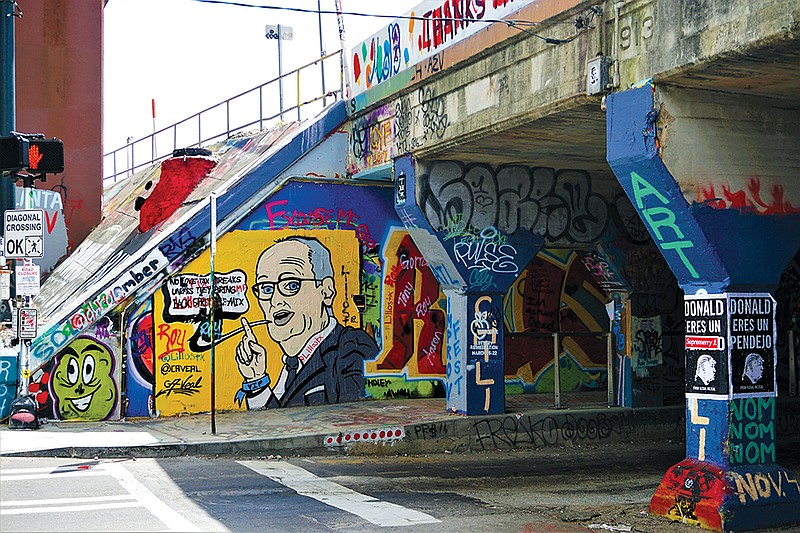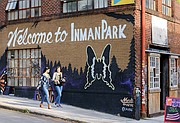Sarah is walking her small terrier, Pepper, on a Sunday morning in the Atlanta neighborhood of Cabbagetown (yes, its real name).
When she moved into the East Atlanta neighborhood in 2014, there was still some iffiness as far as security and feeling safe, she says, but its zone of comfort was spreading quickly. Now she feels no such nervousness.
"I enjoy living here," she says.
It's a common theme across several in-town neighborhoods in East Atlanta that have seen a renaissance in the past 10 to 15 years.
Inman Park. Old Fourth Ward. Sweet Auburn. Grant Park. Little Five Points. Kirkwood. Once burdened by urban decay and sketchy reputations with high crime rates, these neighborhoods have revitalized themselves.
Renovated homes. New condos. New restaurants and businesses. Restored parks. Couples in their 30s. Families with young children.
Once-dilapidated neighborhoods now have their own "downtowns" of locally owned restaurants, clothing boutiques, bookstores, yoga clinics, thrift stores and other businesses. Quaint bungalows from the 1930s sit directly across the street from modern condos.
Residents casually stroll the sidewalks. Owners with their dogs on leashes are everywhere.
It's a mammoth change from 20 years ago when you could buy a house in some of these neighborhoods with the change found between your couch cushions. Now you'll be lucky to find one for less than $500,000, and $1 million homes aren't unusual. In many cases, we're not talking mansions, either.
Stephen Chester moved to Atlanta in 1995 from Kalamazoo, Michigan, and is the founder of ATL Cruzers, a tour guide company that takes visitors through the East Atlanta neighborhoods as well as parts of downtown.
Ten years ago, he bought a home in Grant Park for $250,000. "Now your average house over there is about $850,000," he says.
If you're trying to find a house in neighborhoods such as Virginia-Highland, where many houses are over $1 million, you're out of luck unless you're lightning fast, he says.
"You see people selling and, if they do, within a day or two it's off the market because there's just that much demand to move back into the city," Chester says.
Much of the upscaling is due to the BeltLine, a paved pathway for walking, jogging and biking. Following unused train tracks, when finished it will be 22 miles encircling downtown Atlanta. Much of the finished sections run alongside the East Atlanta neighborhoods, a big draw for their rejuvenation, he says.
"You've got 22 miles and 45 neighborhoods going through a massive economic buildout and, for the most part, a lot of those areas where the train tracks went through are going to be underserved communities," Chester says.
Murals are a constant along the BeltLine. In fact, they're a constant everywhere in the neighborhoods. The annual Forward Warrior project invited professional artists to paint murals along the Wiley Street Wall in Cabbagetown.
A trip with ATL Cruzers is an excellent way to get the lowdown on these in-town neighborhoods. Take a five-seat electric car or, for the more daring, a Segway. The guides (Meghan is especially entertaining) will give you enough information to pass an exam on Atlanta history.
The guides also point out the notable offerings in each neighborhood.
The Vortex Bar and Grill, with locations in Little Five Points and Midtown, is home to the Hell's Fury hamburger --"pepper jack cheese, Atomic Death Sauce, habanero relish and a roasted jalapeño. Not for sissies," the menu says.
Lines are out the door on weekends at Grant Park's Little Tart Bakeshop, customers jonesing for croissants, muffins, cinnamon rolls, pastries, you name it. In 2012, the late chef and worldwide traveler, Anthony Bourdain, walked in, ate a croissant and later praised Little Tart on TV.
Sweet Auburn is home to Ebenezer Baptist Church, where Martin Luther King Jr. was pastor and tombs for him and his wife, Coretta Scott King, are located at the Martin Luther King Jr. National Historical Park on Auburn Avenue. For dining, ABC Chicken and Waffles-Nitro Coffee Counter is ranked as one of the best soul food restaurants in the city.
If you're looking for slightly higher-end dining, Mrs. P's Kitchen and Bar in the Wylie Hotel in the Old Fourth Ward is a good choice. For the choicest dishes, listen to the waitstaff when they make suggestions on what to eat.
In a bit of history, Mrs. P's was the site of the first drag show in Atlanta before police shut it down in the 1980s.
The Wylie was renovated in 2021 and is one of the newest boutique hotels in the area. While nicely appointed, its rooms have an oddity: No closets. Genial staff will happily bring a wheeled hanger rack.
In the Old Fourth Ward, perhaps the best-known place -- and undoubtedly the busiest -- is the Ponce City Market. Located on Ponce de Leon Avenue, a major artery in Atlanta, it's a huge, wide-shouldered brick building, originally home to a Sears & Roebuck store, then Atlanta City Hall and now a combination of a retail marketplace and business offices. Be prepared, it's packed on weekends. Not totally different than most suburban malls, but definitely a tighter fit.
Its unique feature is Skyline Park, a playground on its roof, nine floors up. There is putt-putt, carnival games such as skeeball and goblet toss and a couple of rides, including a three-story slide.
Of course, there also is a stand that serves adult beverages, which means no one under 21 after 5 p.m. on Friday and Saturday. The restaurant, Nine Mile Station, sits next to the playground but is insulated enough to prevent the intrusion of whoops and yells. Its mussels appetizer is delicious and could be an entrée if you get two or three orders.
The first floor is Food Hall, a wealth of food -- Indian, vegan, Chinese, ice cream, baked goods, pizza, even beef jerky. The second floor is home to well-known shops such as Anthropologie, Levi's and Williams Sonoma along with small, privately owned shops.
Getting back to the neighborhoods, we're sure you -- like pretty much everyone who hears it -- are wondering about the source of Cabbagetown's name. Well, that's in some dispute.
One theory is that owners of local produce wagons in the late 1910s discovered that cabbage sold better than other types of produce, so they switched to cabbage only.
Another is that a train carrying a load of cabbages derailed by the Fulton Bag and Cotton Mill, the neighborhood's primary employer, and residents swept in and grabbed them.
Leigh Elbion, a guide at Unexpected Atlanta, which conducts food-and-history tours of several neighborhoods in East Atlanta, prefers the final theory: Scottish people from Appalachia moved to the neighborhood in the early 1880s to work at the mill. Corned beef and cabbage was a meal staple for them, so the pungent and somewhat-rude smell of cooking cabbage enveloped the area.

